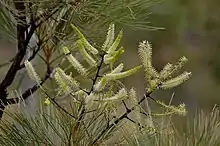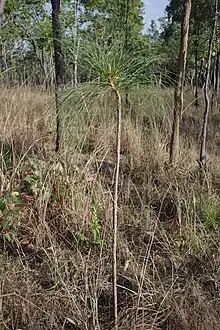Grevillea erythroclada
Grevillea erythroclada, commonly called needle-leaf grevillea,[2] is a species of flowering plant in the family Proteaceae and is endemic to northern Australia. It is a shrub or small tree with divided leaves, the ultimate lobes linear to more or less cylindrical, and clusters of cream-coloured to pale yellow flowers.
| Grevillea erythroclada | |
|---|---|
 | |
| Near Timber Creek | |
| Scientific classification | |
| Kingdom: | Plantae |
| Clade: | Tracheophytes |
| Clade: | Angiosperms |
| Clade: | Eudicots |
| Order: | Proteales |
| Family: | Proteaceae |
| Genus: | Grevillea |
| Species: | G. erythroclada |
| Binomial name | |
| Grevillea erythroclada | |

Description
Grevillea erythroclada is a shrub or tree that typically grows to a height of 2.5–8 m (8 ft 2 in – 26 ft 3 in). It has divided leaves 250–520 mm (9.8–20.5 in) long with five to thirteen primary lobes, sometimes the lobes further divided. The ultimate lobes are linear to more or less cylindrical, 100–360 mm (3.9–14.2 in) long and 0.5–1.8 mm (0.020–0.071 in) wide. The leaves are more or less glabrous and deeply wrinkled. The flowers are arranged in clusters with up to eight branches, each branch cylindrical and 60–180 mm (2.4–7.1 in) long. The flowers are cream-coloured to pale yellow, the pistil 6.5–9 mm (0.26–0.35 in) long. Flowering occurs from September to October and the fruit is a flattened elliptic follicle 19–29 mm (0.75–1.14 in) long.[2][3]
Taxonomy
Grevillea erythroclada was first formally described in 1918 by William Vincent Fitzgerald in Journal and Proceedings of the Royal Society of Western Australia from specimens he collected near the Upper Isdell and Hann Rivers.[4][5] The specific epithet (erythroclada) means "a red young shoot".[6]
Distribution and habitat
Needle-leaf grevillea grows in open woodland, often near watercourses, in scattered locations in the Central Kimberley, Great Sandy Desert, Northern Kimberley and Victoria Bonaparte bioregions of northern Western Australia, in the north of the Northern Territory, and on Cape York Peninsula in Queensland.[2][3][7]
Conservation status
This grevillea is listed as "not threatened" by the Western Australian Department of Biodiversity, Conservation and Attractions, and as of "least concern" under the Territory Parks and Wildlife Conservation Act and the Queensland Government Nature Conservation Act 1992.[2][7][8]
See also
References
- "Grevillea erythroclada". Australian Plant Census. Retrieved 15 April 2022.
- "Grevillea erythroclada". FloraBase. Western Australian Government Department of Biodiversity, Conservation and Attractions.
- "Grevillea erythroclada". Australian Biological Resources Study, Department of Agriculture, Water and the Environment: Canberra. Retrieved 15 April 2022.
- "Grevillea erythroclada". APNI. Retrieved 15 April 2022.
- Fitzgerald, William V. (1918). "The Botany of the Kimberleys, north-west Australia". Journal and Proceedings of the Royal Society of Western Australia. 3: 132–133. Retrieved 15 April 2022.
- Sharr, Francis Aubi; George, Alex (2019). Western Australian Plant Names and Their Meanings (3rd ed.). Kardinya, WA: Four Gables Press. p. 193. ISBN 9780958034180.
- "Grevillea erythroclada". Northern Territory Government. Retrieved 15 April 2022.
- "Species profile - Grevillea erythroclada". Queensland Department of Environment and Science. Retrieved 15 April 2022.